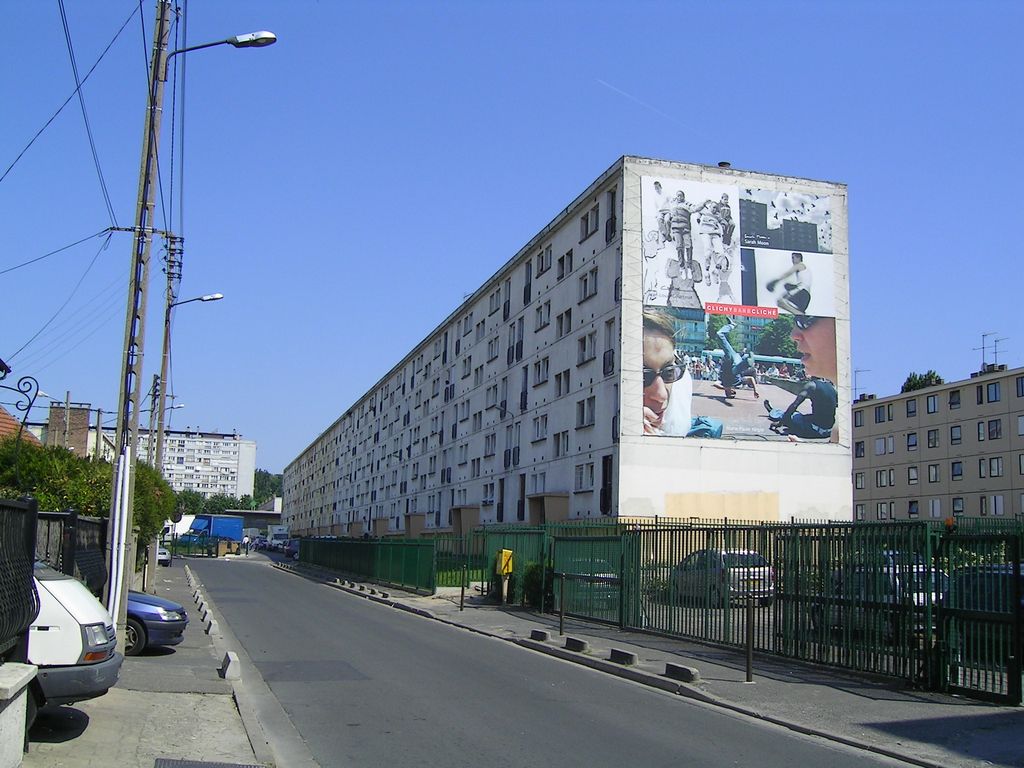I’m going to give you a spoiler under the bar; if you were going to see La Haine [imdb] without my telling you to, go ahead and do so then come back and comment on this posting.
The movie ends with one of the darkest notes, ever, gently intoned by the narrator:
It’s about a society
on its way down,
and as it falls,
it keeps telling itself,
“So far so good…
so far so good…
so far so good.”
It’s not how far you fall that matters.
It’s how you land.
When you get outside of the beautiful old heart of Paris, you reach the “banlieu” – what, in the US, we’d call “the projects.” I suppose in the UK they’d be called “council housing” – it’s terrible. I went to visit a family friend in Neuilly, once, before things started to really get bad, but I stick to the dream-streets of my favorite city. Basically, I have my fingers jammed in my ears and I’m ignoring the tremendous ugliness that underlies everything.

Clichy
If you’re familiar with Morel’s District 13[imdb] it’s a dystopian science fiction movie about the dystopian now. La Haine is a much, much, better movie, but it’ll leave you with a view of France that has nothing to do with baguettes and accordions. The projects outside of Paris are huge, ageing and falling apart, rife with drugs and gangs, policed by militarized cops who understand that their job is to keep the people in the projects from coming into the beautiful society and trying to participate. When La Haine was filmed, there were 3 main divisions: poor white French people, Algerian and Moroccan immigrants from the 60s and 70s, and black immigrants from the former French colonies in Cote D’Ivoire from the 70s. If you were one of the latter two, you were more or less shut out of the French economy so you’ve got poverty, drugs, and despair. Now, add more migrants from Libya, and Tunisia, and a stupid tone-deaf nationalism that is quintessentially French: let’s ban head-scarves, let’s force you to pretend to assimilate into the culture that does not let you assimilate.
La Haine is beautifully shot in black and white, which manages to work without being pretentious – leaching the color from the film sets the underlying tone of empty depressing concrete everywhere; everything is concrete colored. For a movie about poverty and oppression, it’s oppressive.
The plot is simple: it’s a group a friends hanging out the day after a riot. Chekhov’s Gun appears. Things go wrong. It all ends badly.
I feel like I need to emphasize: the Paris presented in La Haine is the real Paris, today.
“so far so good…“
It sounds like the French are not going to elect a racist fascist who promised crackdowns on immigrants. But the problem isn’t getting any better, and it’s gotten a lot worse since La Haine came out in 1995.

District 13 is hardly worth watching, though there’s some really awesome parkour action at the beginning, which makes it almost worthwhile. (Mild spoiler) The movie is about the same thing as La Haine, really, except the politicians have decided on a “final solution” for the projects. Unless you want a version of Escape From New York with none of Snake Plissken’s charm, I’d give this one a miss.
My appetite for dystopian science fiction has waned, since I am living in a dystopian science fiction movie.
As I write this, the first round of the French election is finished, and it’s down to Le Pen against the world. Let’s hope the world wins this round.

According to a poll I saw, Le Pen will get over 40%. Many of her votes will come from people who voted Melenchon, the leftist. So she loses, but almost half of France supports her. That’s different from 25 years ago, when daddy only got 20%.
But would she really make things in the banlieues worse? Or: Would Macron (or any other president) make them better?
I quite enjoyed District 13 in a mostly “mostly mindless and cliched but fun” kind of way. And to be fair, the very heavy-handed metaphor about discrimination would probably have been viewed much differently in post apartheid SA.
Talking of dystopian SF, though, have you seen Sleep Dealer? If not, I heartily recommend it. (And I’ve been doing so every chance I get since I saw it several years ago.)
Technically we’d call them “council estates” in the UK, or “sink estates” for the really bad ones. “Council housing” is a less loaded term, since different local councils have had different policies with regard to low-cost social housing, where it was built and how it was maintained. Many British cities have worked to intersperse council-owned housing with private housing, and avoid having large, isolated, poor areas (estates) on the outskirts or in the inner cities. By no means all, though.
Or “schemes” in Scotland. Well, central Scotland anyway…
Everything I know about Clichy, I learned from Fred Vargas’s books. So, crumbly, run down, traps for the poor.
That’s how it is always done. You rig the game against the poor, the POC, the Other and then blame them and vilify them for not “overcoming adversity.” Set them up to fail and then blame them for their failure.
Shoulda been a subtitle to the OP.
—
FWIW, for me, there is no ‘architectural ugliness’ — function is relevant, form is not.
John Morales
just for fun, look here
http://kunstler.com/featured-eyesore-of-the-month/